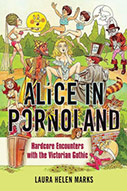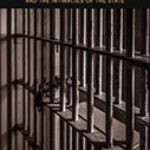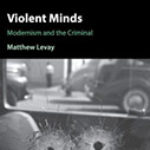Alice In Pornoland: Hardcore Encounters With The Victorian Gothic

Author: Laura Helen Marks
Publisher: Champaign, IL: University of Illinois Press, 2018. 232p.
Reviewer: Lisa Z. Sigel │ July 2020
Alice in Pornoland is a research monograph structured almost as a series of discrete essays. The introduction explains the author’s approach to neo-Victorianism and the theoretical underpinnings of porn studies. The first chapter looks at the use of neo-Victorianism as a set of paratextual framings in pornographic films. Following that are analyses of pornographic adaptions of Dracula, Alice in Wonderland, Dr. Jekyll and Mr. Hyde, and The Picture of Dorian Gray. Each chapter follows key ideas from the nineteenth century, and begins to address why pornography looks backwards to generate meaning from sexuality.
Marks argues that she “looks at pornography as a whole by looking at an interesting and, some might say, esoteric subgenre that has nonetheless appeared in a wide range of eras, locations, and levels of the industry “(Page 9.). She argues that the close examination of “esoteric and selective” Neo-Victorian productions allows her to isolate key pleasures in the genre of pornography. Like Laura Kipnis, Marks sees pornography as prodding “tender spots” in the cultural psyche of modern America. The exploration of neo-Victorian pornography, according to this model, lets us see how hardcore works, and what its aims might be. Her readings of pornographic remakes done between the 1970s and the 2010s of nineteenth-century British fiction bring a great deal that might be of interest to scholars of literature and the media, particularly in the fields of porn studies and sexuality. In some places in the book, Marks explores Victorian texts and their contexts, but her real strength is in the exploration of pornographic film. In a summative chapter, Marks correctly identifies significant problems in the study of pornography ranging from people’s unwillingness to engage with pornography, to an anti-pornography sentiment masquerading as analysis.
While she sees herself as speaking to Victorianism, her framing of the Victorian context is less compelling than her analysis of porn studies. Marks opens the book with a discussion of popular ideas of the Victorian world, but her description does not speak to either popular or academic notions of the Victorian world. She writes: “’Victorian’ might conjure images of white ladies in hoop skirts, covered piano legs, storefronts displaying obscene books and postcards, impoverished children begging on urban sidewalks, white men slaughtering natives in a foreign land, the spectacle of the Hottentot Venus being exhibited by white men as a sexual curiosity, or chivalrous white men helping ladies into carriages” (Page 1.). This list doesn’t include a discussion of Victorian manners, architecture, or dog-breeding as popular ideas. Nor does it mention Victoria herself, her ministers, the Second Empire, the Irish Question, Chartism, industrialization, class formation, suffrage, or the New Woman. Thus, the author’s framework for Victorianism is a narrow one that eschews popular ideas of Victorianism and most of the academic concerns around social and cultural issues in the Victorian world for the sexual realm alone. But by framing it as Victorian, albeit neo-Victorian in many places, the study diminishes where she does her best work, which is in the pornographic framing of an imagined past. She suggests that she will interrogate representations in part to see “the ways that pornographers consciously and unconsciously trace a lineage of sexual discourse and representation from the nineteenth century to the present” (Page 7.). Other than basing pornographic films on certain texts or using nods to neo-Victorianism in corsets and petticoats, that lineage hasn’t been proven, and it might well be interrupted by a modernist sensibility which has been overlooked in this account. Thus, Marks’ engagement with the past has a refracted quality as if the iterations of iterations of the past can stand for the past itself.
In some sense this issue comes from the larger positioning of media studies, an emergent field that has seen fantastic growth in the past few years, but has the challenges that that sort of growth inevitably brings. Alice in Pornoland has been published as part of a Feminist Media Studies Series. That imprimatur matters to understanding what sort of book it is. As an individual contribution by a junior faculty member, it should not be held accountable for the issues in the field, but readers should understand it as a product reflecting a certain nexus that sees what happened to media as the central focus of study. The nuts and bolts challenges of what sort of framework it came from affects everything small to big, from questions of framing, publication, evidence, and citation practices, to questions of where faculty get hired, how to evaluate their dossiers, and what constitutes meaningful contributions. For a media studies scholar to consider the ideas about Dracula, one would expect a focus on TV and films generated from the book, but if that same person gets housed in a literature department, the subject of study would be the book even if scholars would then engage later iterations. In organizing the introduction and first chapter around Victorianism, Marks situates herself in literature departments and their attendant methodologies. In ending with a discussion of porn studies, Marks positions herself squarely in media studies. Conceptually, that might have made sense to go from past to present, but it doesn’t play to her strengths or what the book really delivers.
Marks does a bang-up job of providing a series of close readings of a sub-set of pornographic films based upon a set of classic works. Her readings of pornographic versions of “Alice in Wonderland” frame the films in terms of age and agency and the ways that filmmakers shifted volition from Arthur Dodgson who wrote the texts to Alice as an adult woman who wins at chess and sex. The idea of a “wonderland” and a female exploring imaginary places situated between strangeness and delight provides a set of tensions in pornography. The iconography of wonderland, with its distortions, its focus on eating and drinking, and its overlaps between the animal and human provide lexicon for pornographers where anything can happen. Her readings of Dracula explore the sexual dynamics around bodily fluids, around subversions of gay and straight sexuality, and of male and female agency. Her readings of Dr. Jekyll focus on sameness and difference, self and other and confront the recovery of the socially stigmatized through confrontation with monstrousness. The question of a central duality to the sexual self provides the key pleasure in the Jekyll and Hyde text, one exploited by pornographers through queer and straight interpretations. Her book will certainly be of interest to porn studies scholars. It also provides solid accounts of the ways that pornographers generate new erotic energies from classic texts. In doing so, it raises the possibility that one could find tantalizing glimpses of these erotic constellations in the originals, which opens room for new and interesting interpretations for scholars.
Lisa Z. Sigel, Professor, Department of History, DePaul University


